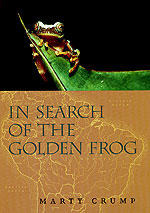"The totally charming journal of an adventurous woman field biologist. You will find yourself living and breathing with Marty every step of the way. This is an odyssey as compelling as it is important."—Thomas E. Lovejoy, Chief Biodiversity Advisor, World Bank
"Incorporating her fieldwork journals, Crump . . . has written an excellent account of her 30 years as a field biologist in Central and South America. . . . [S]he discusses the trials and tribulations of combining motherhood and field research and also explains how the research was done. . . . A combination travelog, field guide, and history book, Crump's book is an excellent addition to any public or academic library."—Library Journal
"Crump's fast-paced, clearly written memoir provides a mix of the day-to-day field experiences of a tropical biologist working in remote, difficult locations, fascinating amphibian biology (some of the described frog behaviors are nothing short of amazing), and the documenting of amphibian population declines in Latin America during the past thirty years. For anyone seeking an unvarnished look at tropical biology fieldwork, this is the book to read."—Les Beletsky, Wildlife Biologist and Series Editor, The Ecotravellers' Wildlife Guides
In Search
of the Golden Frog
Marty Crump
(from Chapter Six: Expressing in the Rain)
28 September 1982
Peter returned to the States last week and will be gone for six weeks more. Life is moving a little slower in the mornings, but overall Karen and I are managing quite admirably by ourselves. Tonight, however, I sorely miss Peter's help.
This morning a tour guide called and invited me to give an after-dinner lecture to a group of Audubon nature tourists who are bird-watching at Monteverde. He asked me to broaden their Costa Rican experience by showing slides of the diversity of tropical amphibians. Helena had agreed to stay with Karen but called thirty minutes before I needed to leave home to say she was sick and unable to come. I call the hotel to cancel my lecture, but the tour leader pleads that I come with Karen and the cook will watch her for me. Against my better judgment, I wrap Karen in a raincoat and we set out in the cool, misty evening air.
When we arrive, the cook hesitantly takes Karen and I begin my talk on "The Many Ways to Beget a Frog." Karen is not pleased at being held by a strange woman who's pacing back and forth the length of the small kitchen. Karen fusses, then cries, then screams so loudly that no one can hear me. Embarrassed, I interrupt my description of poison dart frogs carrying their tadpoles to water, retrieve Karen, and lecture the second half of the hour with Karen strapped to my chest, smiling contentedly at me. Afterward I offer to answer questions. For the next ten minutes, I respond to: "How can you stand to be away from your baby during the day?" "Do you hope she becomes a biologist?" "Aren't you nervous about being in Costa Rica with such a young baby?" Clearly my personal life is more interesting to the bird-oriented tourists than are the reproductive peculiarities of Ecuadorian frogs.
Our hike back up the hill through softly swirling mist seems magical. I look into the night sky and see my first "moonbow": a diffuse ring of pinkish yellow light encircling the moon. My lungs expand with breaths of cool, clean air. Yes, I answered the tourists' questions truthfully. I am very content in this isolated spot away from the stresses and deadlines of Gainesville, Florida. Monteverde is the ideal community for combining motherhood and field biology. Because there are so few outside demands on my time here, I feel in control of my life. Every new mother should be so fortunate.
30 October 1982
I'm thrilled at having located such a dense population of harlequin frogs along the Río Lagarto. Some days I see more than a hundred frogs during a census. And they're so easy to watch. A field biologist's dream come true.
Behaviors of the frogs are fascinating, especially interactions between males and females. Males almost always pounce on females without any courtship preliminaries and grip them in the armpits in a typical mating position. Rejecting these advances, the attacked female responds by kicking to dislodge her unsolicited baggage and by rocking back and forth to dump him off. One female squeezed into a rock crevice and wriggled back and forth as if trying to scrape off the male. Equally dramatic is the response of a female toward a male that suddenly invades her space. She chases the male, pounces on him, and vindictively bounces up and down on his back, vigorously slamming his head against the ground.
This morning while sitting on a boulder watching frogs, I have an eerie feeling that someone or something is watching me. Glancing nervously over my shoulder, I see an otter less than ten meters away, standing on hind feet peering at me. I turn around to see if the male harlequin frog has escaped from the irate female, and by the time I look behind me again the otter has vanished.
12 November 1982
Recently one of my graduate students, Alan Pounds, joined us in Monteverde and has been helping me with the weekly census. Last week at the Río Lagarto, we found a nearly dead harlequin frog with a hole in its hind leg through which we could see wriggling white maggots. Memories of my bot fly during the OTS course more than a decade ago triggered terrifying thoughts. What if these maggots also eat humans? Thirty minutes later, we found another moribund frog with a hole in its hind leg, again with maggots. By the time we left, we had found five more. Our population had been attacked by parasites, but what were they?
We took five victims back to Monteverde and placed them in plastic shoe boxes lined with several layers of paper towel. By today the maggots had consumed most of the flesh and internal organs of the frogs and the frogs died. The maggots crawled in between the layers of paper towel, where we're hoping they'll pupate.
14 November 1982
It worked! The larvae have pupated. Now the wait to see if they'll survive, and if so, what will emerge from the pupae?
 A blue-sided leaf frog waits for action at a breeding pond in Monteverde, Costa Rica. | |
Today is a long day at the Río Lagarto. Midmorning after I express, I rummage through my backpack for my water bottle. Damn, I forgot it and I'm already thirsty. This is not good, because the more water I drink, the more milk I produce. And if I don't express enough milk for Helena to give to Karen, my time in the field is curtailed. I glance at a harlequin frog sitting on a wet boulder and think, "How lovely to be a frog and never have to drink." On their underside, frogs have an area called a seat patch that's especially permeable to water. By merely sitting on wet surfaces, they absorb water into their bodies.
After finishing the day's observations, I slowly plod home along the dirt road exposed to the baking sun, feeling very dehydrated. A marine toad sits in squishy mud by the side of the road, soaking up water through its seat patch. Sitting exposed in the middle of the day, the warty toad isn't as vulnerable to predators as it seems. Huge parotoid glands protruding from the side of its head are filled with potent toxins that ooze out of pores when the toads are molested. A dog that bites into a toad and gets a mouthful of these white secretions is quickly deterred and may even die.
Although these parotoid secretions protect toads, people have long known of their medicinal properties. Eighteenth-century physicians used powder made from dried toads to reduce fever. The Chinese make a powder, called Ch'an Su, from toad secretions. They use this powder for treating heart ailments, drying boils and abscesses, and healing ulcers. Indian folk healers in Veracruz, Mexico, use toad secretions in their medicinal preparations and "love magic" potions. It seems odd that parotoid secretions are so widely used as medicines until you realize they contain epinephrine and norepinephrine—chemicals known to stimulate the human heart and help the body deal with stress.
But medicines aren't the only use humans have found for toad parotoid secretions, some of which contain strong hallucinogenic chemicals. Ancient cultures of Mesoamerica are thought to have used toad secretions as hallucinogens during religious ceremonies. Haitian witch doctors include toad secretions in their concoctions designed to induce near-death comas and to create zombies of their victims. And in my own backyard, in southern Arizona and in California, foolhardy people get high by smoking dried parotoid secretions of Colorado river toads.
1 December 1982
The first of the pupae metamorphosed today, producing a hairy black fly about a centimeter long. I've preserved it so that I can send it to a fly expert in the States and have it identified.
These flies seem to be one of the few predators on harlequin frogs, whose skin contains tetrodotoxin, one of the most potent of all animal toxins known. [Curiously, pufferfishes also contain tetrodotoxin. Puffers are considered a delicacy in Japan, but must be skinned very carefully prior to being cooked. Every year brings reports of fatalities caused by eating improperly skinned puffers.] The bright black and yellow colors of harlequin frogs warn potential predators they are poisonous. Because of their toxicity and warning coloration, they sit exposed on boulders all day, seemingly impervious to predation. Yet their conspicuous behavior may make it easier for parasitic flies to find them.
25 December 1982
Christmas this year is truly a community experience. Six weeks ago everyone who wanted to participate in the gift exchange entered his or her name into the gift draw box and then drew the name of someone else. The idea is to make the gifts by hand. Everyone has been creating and finally Christmas is here.
First we have a Quaker meeting at the schoolhouse. Meeting is a special time of contemplation when participants commune silently with God and nature or share thoughts with the rest of the group. Often at the regular Sunday meeting, the hour drifts along in silence except for the noises of the children, who are always forgiven no matter how much they fidget and whine. Today several people speak aloud: how wonderful it is to have family, friends, and visitors nearby; how thankful they are to live in this idyllic spot; how much they hope that peace will envelop the world. The feeling during and following a meeting is always one of warmth, love, and acceptance. If everyone could share and live Quaker beliefs, what a different place the world would be.
Contributions to the potluck dinner range from tuna pizza to tamales (ground corn and pork wrapped in plantain leaves) and from deadly chocolate fudge to a multilayered cake, each layer separated from the next by a thick layer of dulce de leche (thick syrup made from milk and sugar). As everyone savors the last bit of sugar, Santa (one of Helena's brothers decked out in full regalia) rides up on horseback. Dipping into his huge red pack overflowing with gifts, he calls out the name on each package. Everyone, without exception, seems thrilled with the handmade gifts of clothes, toys, paintings, pottery, or furniture.
18 February 1983
Earlier this month we drove to San José and picked up my parents, who will visit for three weeks. We spent a few days relaxing at the beach, where Karen loved the black volcanic sand (and ate more than her share). At Volcán Irazú, the highest active volcano in the country, we felt transplanted to another planet in the bare landscape of volcanic ash and craters. Cascading waterfalls and gaudy flowers in lowland forest were lovely, but we were glad to leave the heat and humidity behind.
 A male golden toad in the Monteverde Cloud Forest Reserve patiently waits for a female. | |
We've been back at Monteverde for a week, where my folks are impressed with the lush cloud forest. Dad, who spent several years on the island of Mindanao in the Philippines as a guerrilla during World War II, finds many similarities in the vegetation between Mindanao and Monteverde. Mom, on her first visit to a tropical environment, is thrilled to walk amidst bamboo, tree ferns, and orchids.
Predictably, Mom shares my dislike for the sinister-looking scorpions in our house. I've warned her that at night when I stumble into the bathroom, I inevitably find one lying in wait. They scurry out from behind dishes in the kitchen cupboards. And they hide out in our underwear in the drawer and in our shoes and boots. Rule number one: Use a flashlight when walking around the house at night. Rule number two: Be on guard in the kitchen. Rule number three: Shake out your clothes and shoes before putting them on.
Ever since we moved here last July, I've worried that a scorpion will crawl into Karen's crib, she'll roll over on it, and it will sting her. Or she'll see one and grab it to play with or eat. I'm the only one, however, who's been stung so far. While I walked across the bedroom floor in bare feet, a scorpion that was skulking in a crevice between two floorboards whipped out his stinger and nailed my little toe. My foot throbbed for the next twenty-four hours.
Despite my innate fear of scorpions, I must admit they are fascinating creatures. They appear prehistoric for good reason. Except for size, they've changed little in the past 425 million years. One early ancestor, unearthed from Wyoming, was a meter in length! With a shudder, I imagine one of our Monteverde scorpions, the size of my index finger, expanded to a meter. Scorpions stun their prey by injecting poison through a stinger at the tip of the tail, then clawlike mouthparts pulverize the victim. Finally the prey's body parts are liquefied and predigested in an enzyme-filled cavity before they enter the gut. Females give birth to miniature scorpions rather than eggs, and the babies ride piggyback on the mother for several days.
Today I take Mom, Dad, and Karen to the Río Lagarto to see harlequin frogs. With Karen strapped to my back, I take the lead as we wander along the stream bank. Suddenly a green vine snake lazily draped over a tree branch ahead of me sways ever so little. I freeze. Ever since I can remember, my mother has had a phobia about snakes. She would never enter the snake building at the zoo, and I was never allowed to keep garter snakes as pets. How is she going to react? I have to point it out to her, because if she sees it unexpectedly she'll panic. I turn and calmly announce that there is a harmless beautiful vine snake three meters away that I want her to see. Her voice quivers as she bravely says OK. With her feet firmly planted on the ground, she leans forward and cautiously peers into the brush. After a few seconds she turns around, her face ashen. She says she's seen enough, but forcing a smile she admits that it's attractive—in its place.
Of much greater interest are the next two animals we encounter. At a large rock face, I reach into a crevice and extract an ivory-colored, oval-shaped reptile egg. It hatches in my hand and out pops a wet, wide-eyed anole lizard. It cocks its head, looks around, then scampers away into the unknown. I pick up a black female harlequin frog with a yellow heart-shaped pattern to show to Karen. She grabs it from me and immediately tries to stuff it into her mouth. Mom rescues the frog (and Karen) just in time.
The highlight of the day for Dad occurs while we're eating our cheese sandwiches on the stream bank. He sees a long column of jagged leaf fragments cruising along the ground. "Leaf-cutter ants!" he announces. He's thrilled to watch ants efficiently snipping out pieces of leaves, struggling back down the plant stems to the ground with their awkward cargo, communicating with their neighbors by batting antennae as they march toward a large mound of dirt, and then disappearing into the opening of their underground nest.
I talk with Mom about my evolving philosophy concerning my current roles. Ten months ago I naively thought that with the help of a baby-sitter and a part-time housekeeper, life as mother, wife, and field biologist would be relatively routine and straightforward. Wrong! Unexpected minor crises are to be expected. Priorities must be flexible. Karen gets sick and she becomes top priority. My weekly frog census will have to wait a day or two. Peter's experimental plants are withering from an unexpected lack of rain. So that he doesn't lose the months-long experiment, he must spend Sunday doing what sounds like a joke—sprinkling water on his plants in the cloud forest. My role as wife assumes top priority, and I take over Peter's maintenance chores for the day. The harlequin frogs inexplicably change behavior and tolerate their neighbors. The field biologist part of me must set aside other demands and spend the day making observations or the opportunity will be lost. I'm not totally comfortable with my philosophy, but I see it as a compromise. When one role assumes top priority, I can't allow my other two-thirds to feel guilty. They will have their turns tomorrow or next week. And I mustn't feel guilty then. Mom nods sympathetically and assures me that I'm doing a fine job.
14 March 1983
Having studied this population of harlequin frogs since 1980, I'm amazed at how long individuals remain in one place. Some frogs have stayed on the same boulders for two years. We know that some amphibians have homing abilities. That is, if displaced from their home site, they return. After harlequin frogs have jumped out of the way of feral pigs snuffling and rooting in the leaf litter, do they return to their displaced sites? Or what if a tree falls and frightens them into hopping upstream or downstream? Sudden cloudbursts cause temporary flooding. If a frog is washed downstream, does it return to its home site?
 My study site at the Río Lagarto, Costa Rica. In the early 1980s the area was swarming with harlequin frogs, but by 1988 the frogs had mysteriously disappeared. | |
I began to test for homing ability two years ago by picking up frogs and carrying them either ten meters upstream or ten meters downstream before releasing them. Then one week later I censused the stream bank and recorded locations of all individuals. Although some frogs had had to climb over or crawl through massive treefalls to return home, they did it. There was no difference in the tendency between males and females to home, nor in the success of homing from upstream versus downstream. Residents (individuals known to have stayed within 1.5 meters of a spot for at least the previous ten days), however, were much more likely to home than were transients (individuals I had not seen before).
As part of a follow-up experiment to compare homing success during the dry season (now) and the wet season (next June(July), last week I moved forty-four frogs ten meters either upstream or downstream. Three days later I found twenty-five individuals that had already returned to within one meter of their capture spot, most at their identical crevice or boulder. Today, one week after displacement, I find another six frogs that have returned. Thus, 70 percent of the frogs homed; most of the individuals that did not home were probably transients. It'll be interesting to see if the frogs show a different pattern during the wet season.
I've been sampling insects and measuring physical characteristics of the frogs' habitat. During the wet season, I'll repeat the measurements to check for any obvious differences between the seasons. I'll also be able to compare sites from where frogs homed back to, versus those they did not return to.
18 April 1983
Karen wakes up this morning with a fever of 104°F and a red rash on her belly. We flip through our medical encyclopedia and diagnose her symptoms as roseola. Peter draws a tepid bath and immerses a listless baby, who immediately responds with bloodcurdling piercing screams. While Peter attempts to lower Karen's temperature, I run down to the community phone to call the pediatrician in San José. The sudden illness frightens me, and I feel guilty that we've taken our infant daughter to a remote place so far from medical care. If we were back in Gainesville, she could have seen the doctor by now.
Halfway down the hill I run into Lucky, Helena's mother and one of the original Quaker settlers here. She has raised seven children at Monteverde, so I ask her what she did when her kids ran temperatures of 104°F. Her response is reassuring. "I never knew what their temperature was because I never had a thermometer. I just soaked them in cool water." She is so matter-of-fact that I feel relieved.
The pediatrician says that yes, the symptoms strongly suggest roseola. Indeed, he says we should do just what we did, give Karen a tepid bath to reduce the fever and the rash will soon disappear. If not, call him back.
Although there is a small clinic about five kilometers away, we're a long way from expert medical care. At least we have a car and could drive to a real hospital in about three hours. What did the Quakers do in times of emergency thirty years ago? What do people who live in any isolated rural area do in times of emergency? They do their best. And they live with the consequences of inadequate medical care.
My worries dissolve as I walk through the front door and see Peter holding Karen, who grins and reaches out to me. Her fever has subsided, her rash has nearly disappeared, and she almost seems her usual perky self. We lucked out this time.
